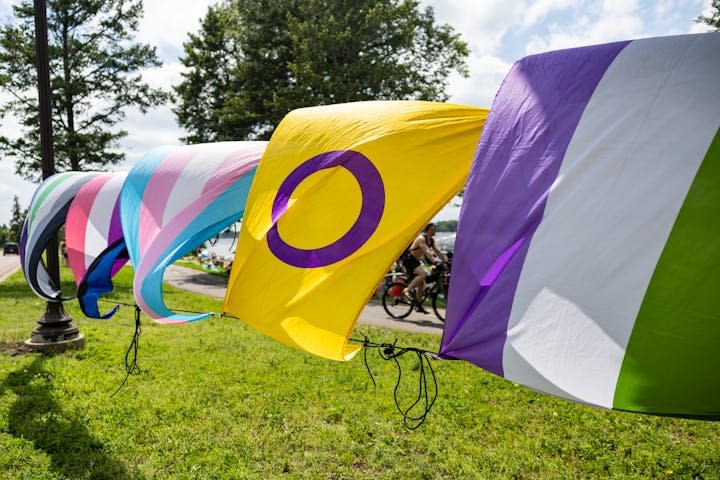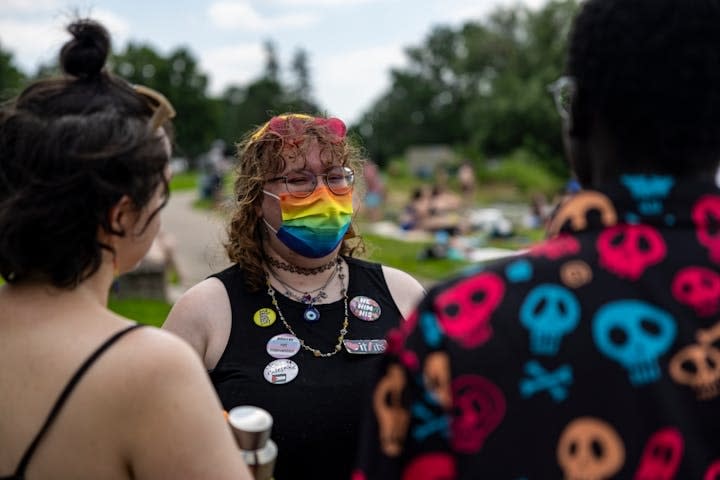Yes, intersex people exist. A Twin Cities advocate is fighting for their rights.
Ly Baumgardt has always had a flair for the dramatic.
So, no one was really surprised with what Baumgardt decided to do on the steps of the Minnesota Capitol a few months ago during a lobbying day for transgender people.
It was Baumgardt's first time talking so publicly about life as an intersex person. But the Hopkins 23-year-old, who has become Minnesota's most public face for this often-ignored or misunderstood group of people born with atypical sexual characteristics, is not shy. So, as they spoke to a couple hundred spectators about how intersex people live in the shadows even more than trans people, Baumgardt removed their coat. Their t-shirt read, "GIRLS WILL BE BOYS." A friend loaded up a syringe with testosterone. Baumgardt rolled up one sleeve, and the friend injected the "T" into their arm.
"Intersex people need to be more in the public eye," Baumgardt said later. "People don't want to acknowledge intersex people exist. Because if they understand sex is a spectrum as well, then they would have to acknowledge there might be more than two genders."
The testosterone is necessary, Baumgardt says, both to fight the chronic fatigue that comes with their intersex variation and for masculinization as part of their gender transition.
For the past several years, headlines have abounded about trans people. Trans people have successfully fought for legal protections in blue-leaning states like Minnesota, while red-leaning states have restricted gender-affirming care and passed laws about bathroom usage and youth sports participation.
But even as some states have banned gender reassignment surgeries, exceptions have been made for surgeries on intersex children, illustrating how intersex people challenge traditional binary views on gender.
Baumgardt was a leading force behind a bill introduced this session by Rep. Liish Kozlowski, the state's first nonbinary legislator. The bill would have banned cosmetic, nonessential surgeries on intersex people younger than 12, surgeries often done on babies with atypical sexual characteristics. The bill never made it to a vote, but advocates point to Baumgardt's work on the legislation as the beginning of a longer battle for further recognizing intersex people.
"This was the very first year anything like this has even been introduced in Minnesota," said Kat Rohn, executive director of OutFront Minnesota. "It's exceedingly rare to have a brand-new piece of legislation go start-to-finish in one session unless there's a clear, broad consensus, and especially on topics people don't know much about. Ly recognizes the urgency of these conversations but also recognizes this is building work."
Searching for identity
Baumgardt's path to the steps of the Minnesota Capitol began as a struggle to understand their identity.
"The first time we had sex education in school, I threw up and got sick," Baumgardt said. "Because I felt so cosmically wrong. They're like, 'You're going to get a period!' 'You're going to have this thing called puberty!' It literally felt like a cosmic incorrectness."
Baumgardt came out as trans at 14 — by reading a poem at the middle school variety show. ("I was the only one to get a standing ovation," they said.) They came out as intersex at 15. Their journey has been punctuated by advocacy. Baumgardt graffitied "VOTE NO" around their elementary school during the runup to the 2012 constitutional amendment that would have banned same-sex marriage. In middle school and high school, they ran the gay-straight alliance and a trans youth club, and they visited other schools to talk with teachers about how to treat trans students.
"I was every stereotype of a social-justice warrior," Baumgardt said.
Baumgardt was studying to be an American Sign Language interpreter when COVID hit. (Their mom is deaf.) They now work for TIGERRS, a group that advocates for transgender, intersex and gender-expansive Minnesotans.
Intersex issues are as complicated and nuanced as Baumgardt's life journey. Intersex is an umbrella term; there are dozens of intersex variations, which can affect people in different ways. Some intersex people have genitals or internal sex organs that fall outside traditional male-female categorization, like someone with both ovarian and testicular tissues. Others have combinations of chromosomes different than XY or XX. Sometimes intersex traits are noticeable at birth, while other times they can be discovered later in life, if ever.
Estimates vary wildly on how many people are intersex, but advocates often claim between 1 and 2 in 100 Americans are intersex — about as common as red hair.
"It's a complicated piece of queer identity," said Rep. Leigh Finke, the first openly transgender Minnesota legislator. "The concept of intersex characteristics is very antithetical to the anti-trans movement. Sexual biology is complicated, far more complicated than the anti-trans movement ever wants to acknowledge. To have a nuanced conversation about intersex traits is going to muddy the waters on what the anti-trans movement is based on, which is that there's no complexity to binary sexual characteristics."
Adding nuance to public dialogue
The most urgent goal for intersex advocates is stopping cosmetic, nonessential surgeries on intersex infants. But more than that, they want to take societal stigma away from being intersex.
Baumgardt tells of experiences with the medical community that have been traumatizing.
"Intersex people have been made to feel like experiments and medical oddities," Baumgardt said. "Doctors will call in other doctors and say, 'Look at how weird this person is, you'll probably never see this again!' People have been made to feel like they're weird or freaks. And there's no way to find community. It's not always visible. You've probably walked past intersex people, and you have no idea."
Baumgardt hopes their advocacy can add nuance to the often binary statewide and national dialogue about gender and sexuality.
"A lot of these laws are like, 'See, there are two genders — a woman is someone who produces eggs,'" Baumgardt said. "But what about an intersex woman who has a vagina but has ovotestes instead of ovaries? It doesn't make any sense to try to medically define a woman, because there's so much variation in what a woman is, so much variation in what a man is. Man and woman are more broad categories than a definite thing. There's variation in male and female.."



